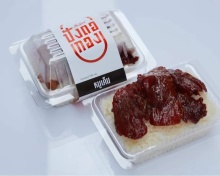Industrial Seaweed Dehydator and Dehumidifier DPHG150S-X
With the successful application of high-temperature heat pump dryers to drying in many industries, more and more kelp processing factories choose to use seafood heat pump dryers. The kelp produced in the kelp drying room is flat, non-sticky, fast drying and good in color. The dried kelp is superior to dried kelp in terms of quality and color.
Several major problems exist when kelp is dried:
1. Production status and existing problems of dehydrated kelp. At present, most of the production of dehydrated kelp adopts the traditional drying method-fire way heating and drying method, which has the following problems:
1. The heating temperature is too high. With traditional drying technology, the heating temperature is not easy to control. Generally, the heating temperature is around 75-90℃, and the drying process of dehydrated vegetables requires that the drying temperature should not exceed 65℃.
2. The drying time is too long. Using traditional methods, it takes at least 24 hours to process 1 ton of vegetables. Even so, reheating and drying are occasionally caused by poor drying effects and rework.
3. Large energy consumption. The traditional drying process has low thermal efficiency, about 30%-60%. During the drying process, the heat of drying and evaporating moisture accounts for about 36%, and the waste gas loss accounts for about 58%. Dry materials take away heat and dryer heat. The losses accounted for 2% and 2% respectively, and the thermal efficiency was only 40%.
 Audited supplier
Audited supplier
How to Dry Seaweed by Twesix Heat Pump Dryer
Seaweed Heat Pump Dryer Drying Process

The first stage: the heating stage-the kelp can be hung onto the trolleys or placed into trays. Close the door, heat the air in the drying room to 50℃, and heat for 1.5-3 hours. When there is moisture in the drying room, the moisture will start to drain. The moisture will be drained for about 2 minutes. After the moisture is drained, the temperature in the drying room will drop. And then continue heating.
The second stage: constant-rate drying and damp-removal stage,which should be divided into two stages: high humidity and low temperature, medium humidity and medium temperature. In the high humidity and low temperature section, the temperature is less than 60 ℃, and the range is 55-60 ℃. Avoid high temperature and high humidity caused by the change of the color of the material. Observe the change of water vapor on the surface of the material and discharge moisture at any time. This time should be 3-3.5 hours. In the middle humidity and middle temperature section, the temperature is less than 60℃, and the range is 50-60℃. In this section, the air inlet valve can be opened and the return air valve can be properly closed for the moisture removal. Reasonably adjust according to the amount of moisture.
Three stages: speed reduction and shaping stage,which also known as low humidity and high temperature section, the temperature in this section is 70-80℃, the early stage should not exceed 70℃, and the later stage should not exceed 80℃.
The seaweed dried by using the seafood heat pump dryer is more stable in quality, better in color, and non-sticky than the seaweed dried by the weather. The seafood heat pump dryer utilizes natural heat for effective conversion, temperature adjustment and dehumidification are performed at the same time, and the cost of non-combustion, non-electric heating, and drying is reduced by 70% compared with traditional methods.
 Audited supplier
Audited supplier
Best Twesix Pork Jerky Drying Machine-DPHG050S-G Supplier

Professional Industrial Green Leaves Drying Machine with Low Temperature manufacturers

TSIX Continuous Chilli Conveyour Belt Dryer with Dehumidifier and Heat Recovery

Mobile 304 Bakery Trolley Racks with Mesh Trays

Stainless Steel Bakery Trolley with 32 trays

How to Install the Detachable Trolley for Drying Food

300kg Sea Buckthorn Berry Drying Machine in Mongolia

TSIX 300kg Sea Buckthorn Berry Drying Machine -DPHG030S-G

Industrial Noodle Dryer Popular in Asia DPHG150S-G Tsix






